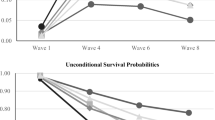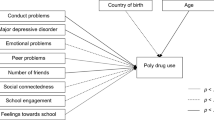Abstract
Tobacco use and its concomitant, nicotine dependence, are increasing in African countries and other parts of the developing world. However, little research has assessed nicotine dependence in South Africa or other parts of the African continent. Previous research has found that adolescent problem behaviors, including tobacco use, tend to cluster. This study examined the relationship between nicotine dependence and adolescent problem behaviors in an ethnically diverse sample of urban South African adolescents. A community sample (N = 731) consisting of “Black,” “White,” “Coloured,” and “Indian” youths aged 12–17 years was drawn from the Johannesburg metropolitan area. Structured interviews were administered by trained interviewers. Nicotine dependence was assessed by the Fagerström Test of Nicotine Dependence. Logistic regression analyses showed that higher levels of nicotine dependence significantly predicted elevated levels of violent behavior, deviant behavior, marijuana and other illegal drug use, binge drinking, early sexual intercourse, multiple sexual partners, and inconsistent condom use, despite control on the adolescents’ demographic characteristics, peer smoking, conflict with parents, peer deviance, and the availability of legal and illegal substances. These relationships were robust across ethnicity and gender. The findings indicate the need for policy makers and prevention and intervention programs in South Africa to consider adolescent nicotine dependence in conjunction with comorbid problem behaviors, including other substance use, sexual risk behaviors, and deviant behaviors.
Similar content being viewed by others
Notes
South Africans were categorized according to their race during apartheid as “Black African” (of African descent), “Coloured” (of mixed European and African descent), “Indian” (of Asian/Indian descent) or “White” (of European descent). These racial categories continue to be employed by the South African census today. The authors do not subscribe to these classifications in any way.
Black adolescents were chosen as the implied reference group because, compared to adolescents of other ethnic groups, they showed the lowest levels of engagement in problem behaviors.
References
Ary, D. V., Duncan, T. E., Biglan, A., Metzler, C. W., Noell, J. W., & Smolkowski, K. (1999a). Development of adolescent problem behavior. Journal of Abnormal Child Psychology, 27, 141–150.
Ary, D. V., Duncan, T. E., Duncan, S. C., & Hops, H. (1999b). Adolescent problem behavior: The influence of parents and peers. Behaviour Research and Therapy, 37, 217–230.
Baker, T. B., Brandon, T. H., & Chassin, L. A. (2004). Motivational influences on cigarette smoking. Annual Review of Psychology, 55, 463–491.
Barrera, M., Jr., Biglan, A., Ary, D., & Li, F. (2001). Replication of a problem behavior model with American Indian, Hispanic, and Caucasian youth. Journal of Early Adolescence, 21, 133–157.
Biglan, A., Duncan, T. E., Ary, D. V., & Smolkowski, K. (1995). Peer and parental influences on adolescent tobacco use. Journal of Behavioral Medicine, 18, 315–330.
Brener, N. D., & Collins, J. L. (1998). Co-occurrence of health-risk behaviors among adolescents in the United States. Journal of Adolescent Health, 22, 209–213.
Brook, J. S., Brook, D. W., Gordon, A. S., Whiteman, M., & Cohen, P. (1990). The psychosocial etiology of adolescent drug use: A family interactional approach. Genetic, Social, and General Psychology Monographs, 116, 111–267.
Busen, N. H., Modeland, V., & Kouzekanani, K. (2001). Adolescent cigarette smoking and health risk behavior. Journal of Pediatric Nursing, 16, 187–193.
Catalano, R. F., & Hawkins, J. D. (1996). The social development model: A theory of antisocial behavior. In J. D. Hawkins (Ed.), Delinquency and crime: Current theories. New York: Cambridge University Press.
Clark, D. B., Wood, D. S., Martin, C. S., Cornelius, J. R., Lynch, K. G., & Shiffman, S. (2005). Multidimensional assessment of nicotine dependence in adolescents. Drug and Alcohol Dependence, 77, 235–242.
Colby, S. M., Tiffany, S. T., Shiffman, S., & Niaura, R. S. (2000). Measuring nicotine dependence among youth: A review of available approaches and instruments. Drug and Alcohol Dependence, 59, S23–S39.
Dolcini, M. M., Adler, N. E., Lee, P., & Bauman, K. E. (2003). An assessment of the validity of adolescent self-reported smoking using three biological indicators. Nicotine & Tobacco Research, 5, 473–483.
Donovan, J. E., & Jessor, R. (1985). Structure of problem behavior in adolescence and young adulthood. Journal of Consulting and Clinical Psychology, 6, 890–904.
Elliott, D. S., Huizinga, D., & Menard, S. (1989). Multiple problem youth: Delinquency, substance use, and mental health problems. New York: Springer.
Fakhfakh, R., Aouina, H., Gharbi, L., Hsairi, H., Achour, N., Lagrue, G., et al. (2003). Smoking dependence and symptoms of anxiety and depression among Tunisian smokers. Revue des Maladies Respiratoires, 20, 850–857.
Fergusson, D. M., Swain-Campbell, N. R., & Horwood, L. J. (2002). Deviant peer affiliations, crime and substance use: A fixed effects regression analysis. Journal of Abnormal and Child Psychology, 30, 419–430.
Flisher, A. J., Parry, C. D. H., Evans, J., Muller, M., & Lombard, C. (2003). Substance use by adolescents in Cape Town: Prevalence and correlates. Journal of Adolescent Health, 32, 58–65.
Flisher, A. J., Ziervogel, C. F., Chalton, D. O., Leger, P. H., & Robertson, B. A. (1996). Risk-taking behaviour of Cape Peninsula high-school students. Part IX. Evidence of a syndrome of adolescent risk behaviour. South African Medical Journal, 86, 1090–1093.
Haddock, C. K., Lando, H., Klesges, R. C., Talcott, G. W., & Renaud, E. A. (1999). A study of the predictive properties of the Fagerström Test for Nicotine Dependence in a population of young smokers. Nicotine & Tobacco Research, 1, 59–66.
Heatherton, T. F., Kozlowski, L. T., Frecker, R. C., & Fagerström, K.-O. (1991). The fagerström test for nicotine dependence: A revision of the Fagerström Tolerance Questionnaire. British Journal of Addiction, 86, 1119–1127.
Iacono, W. G., Malone, S. M., & McGue, M. (2003). Substance use disorders, externalizing psychopathology, and P300 event-related potential amplitude. International Journal of Pscyhophysiology, 48, 147–178.
Iacono, W. G., Malone, S. M., & McGue, M. (2008). Behavioral disinhibition and the development of early-onset addiction: Common and specific influences. Annual Review of Clinical Psychology, 4, 325–348.
Jersild, A. T., Brook, J. S., & Brook, D. W. (1978). The psychology of adolescence (3rd ed.). New York: MacMillan.
Jessor, R., Donavan, J. E., & Costa, F. M. (1991). Beyond adolescence: Problem behavior and young adult development. Cambridge, UK: Cambridge University Press.
Kandel, D. B. (1996). The parental and peer contexts of adolescent deviance: An algebra of interpersonal influences. Journal of Drug Issues, 26, 289–315.
Kreek, M. J., Nielsen, D. A., Butelman, E. R., & LaForge, K. S. (2005). Genetic influences on impulsivity, risk taking, stress responsivity and vulnerability to drug abuse and addiction. Nature Neuroscience, 8, 1450–1457.
McMahon, R. J. (1999). Child and adolescent psychopathology as risk factors for subsequent tobacco use. Nicotine & Tobacco Research, 1(2), S45–S50.
Morojele, N. K., Brook, J. S., & Kachieng’a, M. (2006). Perceptions of sexual risk behaviours and substance abuse among adolescents in South Africa: A qualitative investigation. AIDS Care, 18, 215–219.
Morojele, N. K., Flisher, A. J., Muller, M., Ziervogel, C. F., Reddy, P., & Lombard, C. J. (2002). Measurement of risk and protective factors of drug use and antisocial behaviour among high school students in South Africa. Journal of Drug Education, 32, 25–39.
Mzileni, O., Sitas, F., Steyn, K., Carrara, H., & Bekker, P. (1999). Lung cancer, tobacco, and environmental factors in the African population of the Northern Province, South Africa. Tobacco Control, 8, 398–401.
National Institute on Drug Abuse (2005). Monitoring the future. national results on adolescent drug use. overview of key findings 2004. National Institutes of Health. US Department of Health and Human Services.
Ndiaye, M., Ndir, M., Quantin, X., Demoly, P., Godard, P., & Bousquet, J. (2003). Smoking habits, attitudes and knowledges of medical students of medicine, pharmacy and Odonto-stomatology’s Faculty of Dakar, Senegal. Revue des Maladies Respiratoires, 20, 701–709.
O’Loughlin, J., DiFranza, J., Tyndale, R. F., Meshefedjian, G., McMillan-Davey, E., Clarke, P. B. S., et al. (2003). Nicotine-dependence symptoms are associated with smoking frequency in adolescents. American Journal of Preventive Medicine, 25, 219–225.
Panday, S., Reddy, S. P., Ruiter, R. A. C., Bergström, E., & de Vries, H. (2007). Nicotine dependence and withdrawal symptoms among occasional smokers. Journal of Adolescent Health, 40, 144–150.
Parry, C. D. H., Morojele, N. K., Saban, A., & Flisher, A. J. (2004). Brief report: Social and neighborhood correlates of adolescent drunkenness: A pilot study in Cape Town, South Africa. Journal of Adolescence, 27, 369–374.
Reddy, S. P., Panday, S., Swart, D., Jinabhai, C. C., Amosun, S. L., James, S., et al. (2003). Umthenthe Uhlaba Usamila: The South African youth risk behaviour survey 2002. Cape Town: South African Medical Research Council.
Robinson, M. L., Berlin, I., & Moolchan, E. T. (2004). Tobacco smoking trajectory and associated ethnic differences among adolescent smokers seeking cessation treatment. Journal of Adolescent Health, 35, 217–224.
Schaefer, E. S., & Finkelstein, N. W. (1975). Child behavior toward parents: An inventory and factor analysis. Paper presented at the meeting of the American Psychological Association, Chicago, IL.
Sitas, F., Urban, M., Bradshaw, D., Kielkowski, D., Bah, S., & Peto, R. (2004). Tobacco attributable deaths in South Africa. Tobacco Control, 13, 396–399.
Unger, J. B., Sussman, S., & Dent, C. W. (2003). Interpersonal conflict tactics and substance use among high-risk adolescents. Addictive Behaviors, 28, 979–987.
Valois, R. F., Oeltman, J. E., Waller, J., & Hussey, J. R. (1999). Relationship between number of sexual intercourse partners and selected health risk behaviors among public high school adolescents. Journal of Adolescent Health, 25, 328–335.
Yazidi, A. (2002). Smoking in Casablanca hospitals: Knowledge, attitudes and practices. Revue des Maladies Respiratoires, 19, 405–408.
Acknowledgments
The authors thank the Community Agency for Social Enquiry (CASE) for the data collection, and Zohn Rosen for assisting in writing preliminary versions of the Methods and Results sections. The work for this study was performed at NYU School of Medicine. This study was funded by two grants from the National Institutes of Health (USA): TW05391, awarded by the Fogarty International Center to Dr. David W. Brook; and Research Scientist Award DA00244, from the National Institute on Drug Abuse to Dr. Judith S. Brook.
Conflicts of interest statement
The material contained in this manuscript represents original work, has not been published elsewhere, and is not under consideration for publication elsewhere. Our findings pose no conflicts of interest. The authors have full control of all primary data and agree to allow the journal to review the data if requested.
Author information
Authors and Affiliations
Corresponding author
Rights and permissions
About this article
Cite this article
Pahl, K., Brook, D.W., Morojele, N.K. et al. Nicotine dependence and problem behaviors among urban South African adolescents. J Behav Med 33, 101–109 (2010). https://doi.org/10.1007/s10865-009-9242-3
Received:
Accepted:
Published:
Issue Date:
DOI: https://doi.org/10.1007/s10865-009-9242-3




